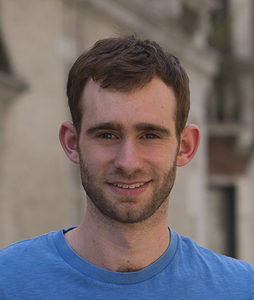Equations of Water Waves Put to the Test

Ben Harrop-Griffiths’ love of mathematics began with a rowboat. Raised in London, he spent a lot of time on the Thames, and his rowing coach, who was also his mathematics teacher, enjoyed gadgets as much as he enjoyed equations. Harrop-Griffiths recalls that the boats had one gizmo that measured the angle of an oar and the force put on it during a stroke. “You had good information about how everybody in the boat was rowing,” he says. His coach had also found a differential equation describing a rowing stroke. Harrop-Griffiths’ numerical solution to the equation loosely agreed with the data.
Ever since those teenage years, Harrop-Griffiths has been studying differential equations of water in some form. He is now a Simons Society Junior Fellow at the Courant Institute of Mathematical Sciences at New York University. Recently, I spoke with him about his work. An edited version of the interview follows.
What kind of differential equations do you study?
A differential equation is a rule for how some object changes. Everything I look at depends on space and time — two or more variables — so we call that a partial differential equation, as opposed to an ordinary differential equation, which has one variable.
I study certain kinds of partial differential equations called dispersive equations. They govern objects that behave like waves, for example, the height of the surface of the ocean. These equations have the property that different frequency waves will travel at different velocities, which causes solutions to spread out or disperse.
Why do you study these kinds of equations?
There are two motivations. One is that they are interesting mathematical objects. Another is that we use the equations as models to inform us about what happens in the real world. If I can say something that advances our appreciation of our world, that’s fantastic.
How do you visualize these kinds of equations in your mind?
One way to think about solutions to these equations is to think of something that starts out looking like a lump. Different kinds of effects can make the lump travel, spread out faster or become more focused. When you look at an equation, you want to understand the balance between the way things spread out and the way things focus.
You focus on Korteweg–de Vries, or KdV, equations. What are they?
These are a specific type of dispersive partial differential equation, which arise particularly in wave propagation at certain scales. The easiest place to see this equation is in a canal. Something narrow, long and quite shallow in terms of water depth, and you ask, what happens to the height of the surface?
Typically, if you disturb the surface, you start off with oscillations, which spread out. Eventually everything goes flat, if you have an infinitely long canal. But you can have solutions that don’t spread out, for example, solitary waves or solitons, which occur when the spreading and focusing effects are perfectly in balance and therefore the waves retain their shape as they move.
Why do you work with this specific type of equation?
The KdV equation arises as an asymptotic limit of numerous physical equations, for example, models of water waves or of wave propagation in plasmas. It is really an approximation of these much more complicated equations. We want to know if we can come up with really good techniques for solving the KdV equation that we can then use to solve the more complicated ones. We’re actually now looking at the full water wave equations for the canal. Some of what we know is true for the KdV is true for this equation.
Why can’t a computer give you answers about these equations?
Computers have a limit on how long they can compute. A computer would work on an equation and make an approximation, first at time zero, then a second later, and a second after that, and so forth. It can only compute some fixed amount of time depending on how long you’re willing to run your program and how good your program is. With pen and paper, I should be able to tell you what happens if you compute for a billion years.
When it comes to open questions in math and science, which do you hope are answered during your career?
The Navier-Stokes existence and smoothness problem, which is a Clay Millennium Prize problem, is a high profile one I’d be interested to know the answer to. These equations don’t really have common features with the equations I study, but they come from the same real-world situations, namely, fluid mechanics. Of course, in the field of dispersive partial differential equations, water waves are proving to be a very good motivating source for problems. Having an appreciation of what happens in these water wave models will be a fantastic thing to know.
The Simons Society of Fellows is a community of scholars that encourages intellectual interactions across disciplines and across research centers in the New York City area.


